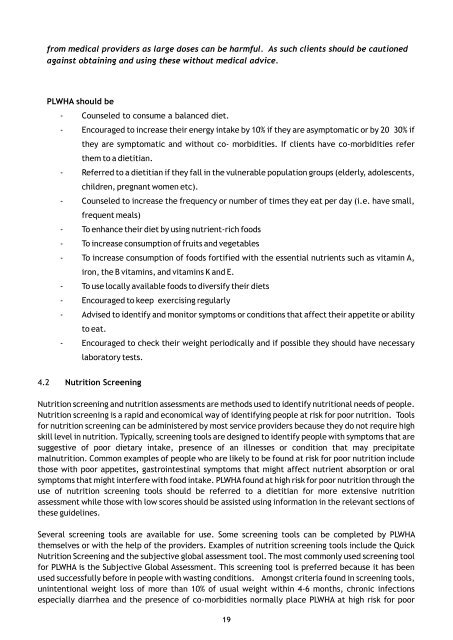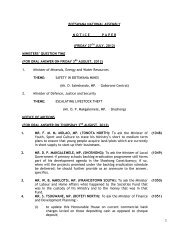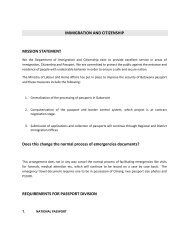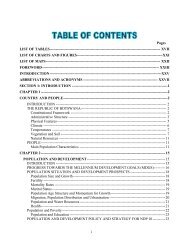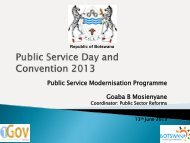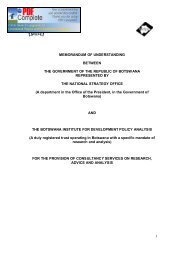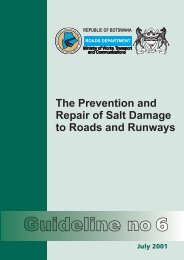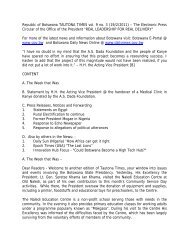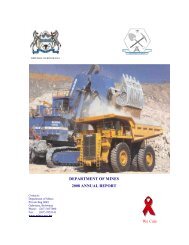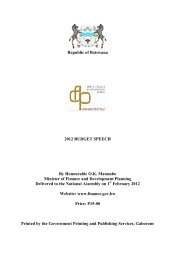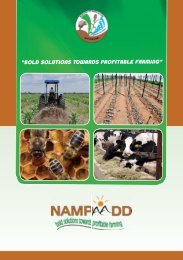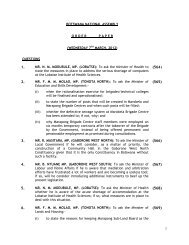National Nutrition and HIV/AIDS Guidelines for Service Providers of ...
National Nutrition and HIV/AIDS Guidelines for Service Providers of ...
National Nutrition and HIV/AIDS Guidelines for Service Providers of ...
Create successful ePaper yourself
Turn your PDF publications into a flip-book with our unique Google optimized e-Paper software.
from medical providers as large doses can be harmful. As such clients should be cautioned<br />
against obtaining <strong>and</strong> using these without medical advice.<br />
PLWHA should be<br />
- Counseled to consume a balanced diet.<br />
- Encouraged to increase their energy intake by 10% if they are asymptomatic or by 20 30% if<br />
they are symptomatic <strong>and</strong> without co- morbidities. If clients have co-morbidities refer<br />
them to a dietitian.<br />
- Referred to a dietitian if they fall in the vulnerable population groups (elderly, adolescents,<br />
children, pregnant women etc).<br />
- Counseled to increase the frequency or number <strong>of</strong> times they eat per day (i.e. have small,<br />
frequent meals)<br />
- To enhance their diet by using nutrient-rich foods<br />
- To increase consumption <strong>of</strong> fruits <strong>and</strong> vegetables<br />
- To increase consumption <strong>of</strong> foods <strong>for</strong>tified with the essential nutrients such as vitamin A,<br />
iron, the B vitamins, <strong>and</strong> vitamins K <strong>and</strong> E.<br />
- To use locally available foods to diversify their diets<br />
- Encouraged to keep exercising regularly<br />
- Advised to identify <strong>and</strong> monitor symptoms or conditions that affect their appetite or ability<br />
to eat.<br />
- Encouraged to check their weight periodically <strong>and</strong> if possible they should have necessary<br />
laboratory tests.<br />
4.2 <strong>Nutrition</strong> Screening<br />
<strong>Nutrition</strong> screening <strong>and</strong> nutrition assessments are methods used to identify nutritional needs <strong>of</strong> people.<br />
<strong>Nutrition</strong> screening is a rapid <strong>and</strong> economical way <strong>of</strong> identifying people at risk <strong>for</strong> poor nutrition. Tools<br />
<strong>for</strong> nutrition screening can be administered by most service providers because they do not require high<br />
skill level in nutrition. Typically, screening tools are designed to identify people with symptoms that are<br />
suggestive <strong>of</strong> poor dietary intake, presence <strong>of</strong> an illnesses or condition that may precipitate<br />
malnutrition. Common examples <strong>of</strong> people who are likely to be found at risk <strong>for</strong> poor nutrition include<br />
those with poor appetites, gastrointestinal symptoms that might affect nutrient absorption or oral<br />
symptoms that might interfere with food intake. PLWHA found at high risk <strong>for</strong> poor nutrition through the<br />
use <strong>of</strong> nutrition screening tools should be referred to a dietitian <strong>for</strong> more extensive nutrition<br />
assessment while those with low scores should be assisted using in<strong>for</strong>mation in the relevant sections <strong>of</strong><br />
these guidelines.<br />
Several screening tools are available <strong>for</strong> use. Some screening tools can be completed by PLWHA<br />
themselves or with the help <strong>of</strong> the providers. Examples <strong>of</strong> nutrition screening tools include the Quick<br />
<strong>Nutrition</strong> Screening <strong>and</strong> the subjective global assessment tool. The most commonly used screening tool<br />
<strong>for</strong> PLWHA is the Subjective Global Assessment. This screening tool is preferred because it has been<br />
used successfully be<strong>for</strong>e in people with wasting conditions. Amongst criteria found in screening tools,<br />
unintentional weight loss <strong>of</strong> more than 10% <strong>of</strong> usual weight within 4-6 months, chronic infections<br />
especially diarrhea <strong>and</strong> the presence <strong>of</strong> co-morbidities normally place PLWHA at high risk <strong>for</strong> poor<br />
19


